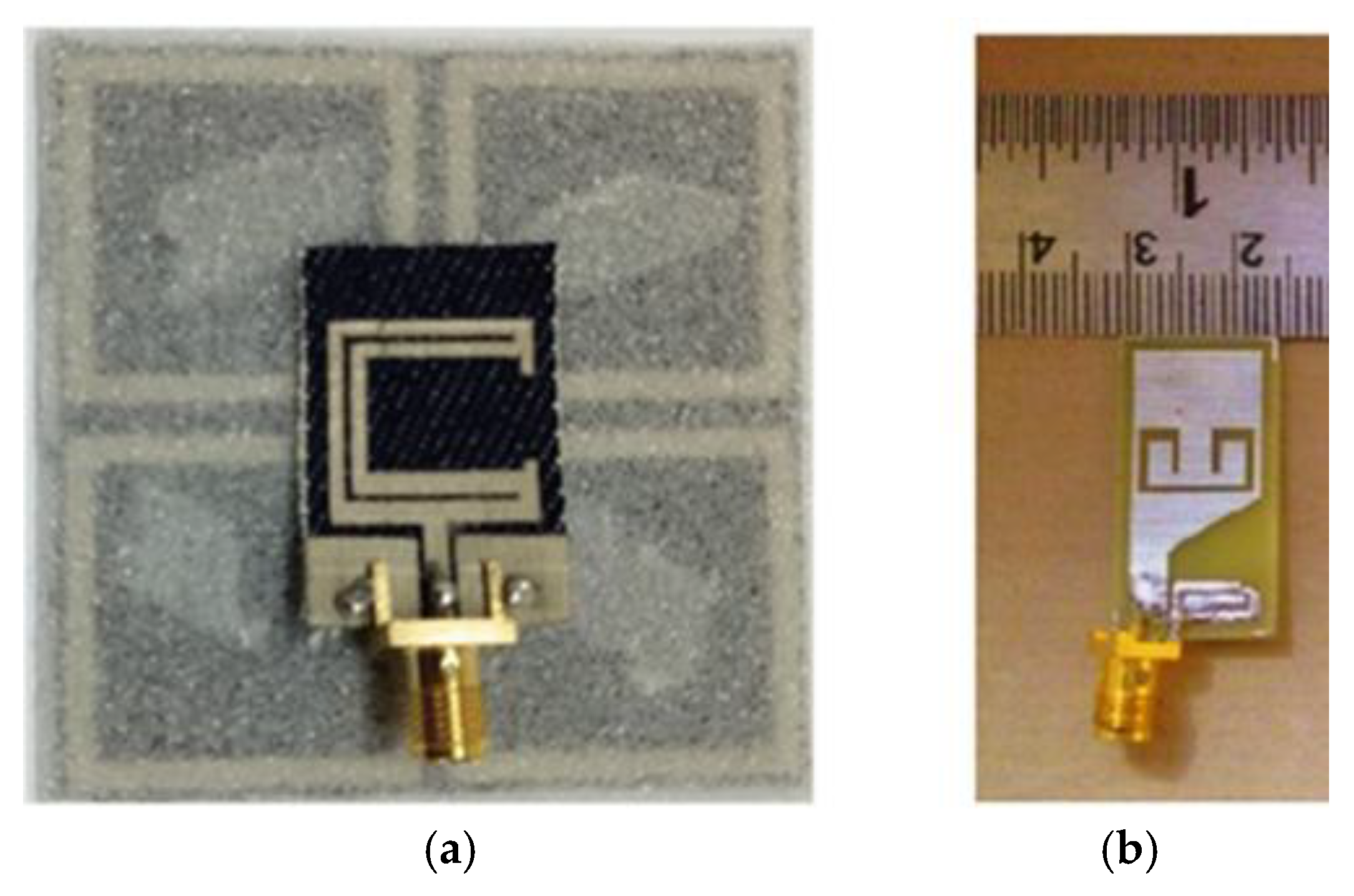Advancements in Wearable Antenna Design: A Comprehensive Review of Materials, Fabrication Techniques, and Future Trends in Wireless Communication
Abstract
1. Introduction
2. The Evolution of Wearable Antenna Technology
3. The Design and Processing Technology of Wearable Antennas
3.1. Materials Utilized in the Fabrication of Wearable Antennas
3.1.1. Conductive Materials
3.1.2. Substrate Materials
3.2. Antenna Fabrication Techniques
3.2.1. Screen Printing
3.2.2. Inkjet Printing
3.2.3. Sewing or Embroidery
3.2.4. Substrate-Integrated Waveguides (SIW)
3.3. Antenna Miniaturization Technology
3.3.1. Dielectric Substrate with High Dielectric Constant
3.3.2. Surface Grooving
3.3.3. Short-Circuit Pins
3.4. Frequency Selective Surface (FSS)
3.5. Antenna Feeding Technology
3.5.1. Coaxial Feed
3.5.2. Microstrip Feeding
3.5.3. Coplanar Waveguide Feed (CPW)
3.5.4. Adjacent-Coupled Feed
3.6. Bionic Design of Wearable Antennas
4. Performance of Wearable Antennas
4.1. Specific Absorption Rate
4.2. Bendability
5. Applications of Wearable Antennas
5.1. Cancer Detection
5.2. Vital Signs Monitoring
5.3. Other Applications
6. Perspectives of Wearable Antennas
7. Comparisons
8. Conclusions
Author Contributions
Funding
Institutional Review Board Statement
Informed Consent Statement
Conflicts of Interest
Abbreviations
| AMC | Artificial Magnetic Conductor |
| ACS | Asymmetric Coplanar Strip |
| AI | Artificial Intelligence |
| ADS | Advanced Design System |
| BiLSTM | Bidirectional Long Short-Term Memory |
| CAGR | Compound Annual Growth Rate |
| CPW | Coplanar Waveguide Feed |
| CPS | Cardiopulmonary Stethoscope |
| CEM | Computational Electromagnetics |
| CST | Computational Simulation Techniques |
| CIOA | Circle-Inspired Optimization Algorithm |
| CNN | Convolutional Neural Networks |
| DL | Deep Learning |
| DNN | Deep Neural Network |
| ECGs | Electrocardiograms |
| EEGs | Electroencephalograms |
| EBG | Electromagnetic Bandgap |
| FSS | Frequency Selective Surface |
| FCC | Federal Communications Commission |
| FBR | Front-To-Back Ratio |
| FDTD | Finite-Difference Time-Domain |
| FEM | Finite-Element Method |
| GPS | Global Positioning System |
| GAF | Graphene Assembled Film |
| HFSS | High Frequency Structure Simulator |
| IoT | Internet of Things |
| ICNIRP | International Commission on Non-Ionizing Radiation Protection |
| IEEE | International Institute of Electrical and Electronics Engineers |
| MIMO | Multiple-Input Multiple-Output |
| MoM | Method of Moments |
| ML | Machine Learning |
| NSGA-III | Non-dominated Sorting Genetic Algorithm III |
| PCB | Printed Circuit Board |
| PET | Polyethylene Terephthalate |
| RCS | Radar Cross-Section |
| SAR | Specific Absorption Rate |
| SIW | Substrate-Integrated Waveguide |
| SHCNN | Siamese Heterogeneous Convolutional Neural Network |
| SCA | Sine Cosine Algorithm |
| TCN | Temporal Convolutional Network |
| TCF | Transparent Conductive Film |
| UWB | Ultra-Wideband |
| UHF-RFID | Ultra-High Frequency Radio Frequency Identification |
| WLAN | Wireless Local Area Network |
| WBAN | Wireless Body Area Network |
| Wi-MAX | World Interoperability for Microwave Access |
References
- Soh, P.J.; Vandenbosch, G.A.; Mercuri, M.; Schreurs, D.M.P. Wearable wireless health monitoring: Current developments, challenges, and future trends. IEEE Microw. Mag. 2015, 16, 55–70. [Google Scholar] [CrossRef]
- Liu, S.Q.; Zhang, J.C.; Zhu, R. A wearable human motion tracking device using micro flow sensor incorporating a micro accelerometer. IEEE Trans. Biomed. Eng. 2019, 67, 940–948. [Google Scholar] [CrossRef]
- Sunehra, D.; Sreshta, V.S.; Shashank, V.; Goud, B.U.K. Raspberry Pi based smart wearable device for women safety using GPS and GSM technology. In Proceedings of the 2020 IEEE international conference for innovation in technology (INOCON), Bengaluru, India, 6–8 November 2020; IEEE: Piscataway, NJ, USA, 2020; pp. 1–5. [Google Scholar]
- Aun, N.F.M.; Soh, P.J.; Al-Hadi, A.A.; Jamlos, M.F.; Vandenbosch, G.A.; Schreurs, D. Revolutionizing wearables for 5G: 5G technologies: Recent developments and future perspectives for wearable devices and antennas. IEEE Microw. Mag. 2017, 18, 108–124. [Google Scholar] [CrossRef]
- Dian, F.J.; Vahidnia, R.; Rahmati, A. Wearables and the Internet of Things (IoT), applications, opportunities, and challenges: A Survey. IEEE Access 2020, 8, 69200–69211. [Google Scholar] [CrossRef]
- Waly, M.I.; Smida, A.; Aljarallah, N.A.; Ghayoula, R.; Negm, A.S.; Muhammad, S.; Tiang, J.J.; Iqbal, A. Advancement of a high-efficiency wearable antenna enabling wireless body area networks. IEEE Access 2023, 11, 138325–138335. [Google Scholar] [CrossRef]
- Jeong, M.J.; Hussain, N.; Bong, H.U.; Park, J.W.; Shin, K.S.; Lee, S.W.; Rhee, S.Y.; Kim, N. Ultrawideband microstrip patch antenna with quadruple band notch characteristic using negative permittivity unit cells. Microw. Opt. Technol. Lett. 2020, 62, 816–824. [Google Scholar] [CrossRef]
- Paracha, K.N.; Rahim, S.K.A.; Soh, P.J.; Khalily, M. Wearable antennas: A review of materials, structures, and innovative features for autonomous communication and sensing. IEEE Access 2019, 7, 56694–56712. [Google Scholar] [CrossRef]
- Salonen, P.; Sydanheimo, L.; Keskilammi, M.; Kivikoski, M. A small planar inverted-F antenna for wearable applications. In Proceedings of the Digest of Papers. Third International Symposium on Wearable Computers, San Francisco, CA, USA, 18–19 October 1999; IEEE: Piscataway, NJ, USA, 1999; pp. 95–100. [Google Scholar]
- Salonen, P.; Rantanen, J. A dual-band and wide-band antenna on flexible substrate for smart clothing. In Proceedings of the IECON’01. 27th Annual Conference of the IEEE Industrial Electronics Society (Cat. No. 37243), Denver, CO, USA, 29 November –2 December 2001; IEEE: Piscataway, NJ, USA, 2001; pp. 125–130. [Google Scholar]
- Salonen, P.; Keskilammi, M.; Rantanen, J.; Sydanheimo, L. A novel Bluetooth antenna on flexible substrate for smart clothing. In Proceedings of the 2001 IEEE International Conference on Systems, Man and Cybernetics. e-Systems and e-Man for Cybernetics in Cyberspace (Cat. No. 01CH37236), Tucson, AZ, USA, 7–10 October 2001; IEEE: Piscataway, NJ, USA, 2001; pp. 789–794. [Google Scholar]
- Tanaka, M.; Jang, J.H. Wearable microstrip antenna. In Proceedings of the IEEE Antennas and Propagation Society International Symposium. Digest. Held in conjunction with: USNC/CNC/URSI North American Radio Sci. Meeting (Cat. No. 03CH37450), Columbus, OH, USA, 22–27 June 2003; IEEE: Piscataway, NJ, USA, 2003; pp. 704–707. [Google Scholar]
- Locher, I.; Klemm, M.; Kirstein, T.; Troster, G. Design and characterization of purely textile patch antennas. IEEE Trans. Adv. Packag. 2006, 29, 777–788. [Google Scholar] [CrossRef]
- Salonen, P.; Yang, F.; Rahmat-Samii, Y.; Kivikoski, M. WEBGA-wearable electromagnetic band-gap antenna. In Proceedings of the IEEE Antennas and Propagation Society Symposium, Monterey, CA, USA, 16–21 June 2002; IEEE: Piscataway, NJ, USA, 2004; pp. 451–454. [Google Scholar]
- Zhu, S.; Langley, R. Dual-band wearable textile antenna on an EBG substrate. IEEE Trans. Antennas Propag. 2009, 57, 926–935. [Google Scholar] [CrossRef]
- Hong, S.; Kang, S.H.; Kim, Y.; Jung, C.W. Transparent and flexible antenna for wearable glasses applications. IEEE Trans. Antennas Propag. 2016, 64, 2797–2804. [Google Scholar] [CrossRef]
- Hong, S.; Kim, Y.; Jung, C.W. Transparent microstrip patch antennas with multilayer and metal-mesh films. IEEE Antennas Wirel. Propag. Lett. 2016, 16, 772–775. [Google Scholar] [CrossRef]
- Bernardo, M.G.; Freire, R.C.S.V.; De Queiroz, A.K.F.; Araujo, J.I.L.; Morais, S.M.A.; Serres, A.J.R.; da Silva, P.F. Aperture-coupled on-chip patch antennas for ISM band 60 GHz. In Proceedings of the 2017 2nd International Symposium on Instrumentation Systems, Circuits and Transducers (INSCIT), Fortaleza, Brazil, 27–31 August 2017; IEEE: Piscataway, NJ, USA, 2017; pp. 1–4. [Google Scholar]
- Kaur, G.; Singh, A.; Mittal, D.; Kaur, A.; Panday, P.; Sidhu, E. Performance analysis of conductive patch materials for the design and fabrication of microstrip patch antennas. In Proceedings of the 2017 Progress in Electromagnetics Research Symposium-Spring (PIERS), St. Petersburg, Russia, 22–25 May 2017; IEEE: Piscataway, NJ, USA, 2017; pp. 502–508. [Google Scholar]
- Elmobarak, H.A.; Himdi, M.; Castel, X.; Rahim, S.K.A.; Geok, T.K. Flexible patch antenna array operating at microwaves based on thin composite material. IEEE Access 2022, 10, 115663–115672. [Google Scholar] [CrossRef]
- Liu, Y.; Yu, M.; Xu, L.; Li, Y.; Ye, T.T. Characterizations and optimization techniques of embroidered RFID antenna for wearable applications. IEEE J. Radio. Freq. Identif. 2019, 4, 38–45. [Google Scholar] [CrossRef]
- Alonso-González, L.; Ver-Hoeye, S.; Fernández-García, M.; Vázquez-Antuña, C.; Andrés, F.L.H. On the development of a novel mixed embroidered-woven slot antenna for wireless applications. IEEE Access 2019, 7, 9476–9489. [Google Scholar] [CrossRef]
- Le, V.; Lemmer, U.; Mackensen, E. Analysis of miniaturized printed flexible RFID/NFC antennas using different carrier substrates. IEEE J. Radio Freq. Identif. 2020, 4, 428–437. [Google Scholar] [CrossRef]
- Al-Gburi, A.J.A.; Radi, N.H.M.; Saeidi, T.; Mohammed, N.J.; Zakaria, Z.; Das, G.S.; Buragohain, A.; Ismail, M.M. Superconductive and flexible antenna based on a tri-nanocomposite of graphene nanoplatelets, silver, and copper for wearable electronic devices. J. Sci. Adv. Mater. Dev. 2024, 9, 100773. [Google Scholar] [CrossRef]
- Ali Khan, M.U.; Raad, R.; Tubbal, F.; Theoharis, P.I.; Liu, S.; Foroughi, J. Bending analysis of polymer-based flexible antennas for wearable, general IoT applications: A review. Polymers 2021, 13, 357. [Google Scholar] [CrossRef] [PubMed]
- Zhang, J.; Song, R.; Zhao, X.; Fang, R.; Zhang, B.; Qian, W.; Zhang, J.; Liu, C.; He, D. Flexible graphene-assembled film-based antenna for wireless wearable sensor with miniaturized size and high sensitivity. ACS Omega 2020, 5, 12937–12943. [Google Scholar] [CrossRef]
- Lin, X.; Chen, Y.; Gong, Z.; Seet, B.C.; Huang, L.; Lu, Y. Ultrawideband textile antenna for wearable microwave medical imaging applications. IEEE Trans. Antennas Propag. 2020, 68, 4238–4249. [Google Scholar] [CrossRef]
- Montisci, G.; Mura, G.; Muntoni, G.; Casula, G.A.; Chietera, F.P.; Aburish-Hmidat, M. A curved microstrip patch antenna designed from transparent conductive films. IEEE Access 2022, 11, 839–848. [Google Scholar] [CrossRef]
- Samantaray, D.; Bhattacharyya, S. A gain-enhanced slotted patch antenna using metasurface as superstrate configuration. IEEE Trans. Antennas Propag. 2020, 68, 6548–6556. [Google Scholar] [CrossRef]
- Zhang, Y.; Lin, S.; Li, Y.; Cui, J.; Dai, F.; Jiao, J.; Denisov, A. Wideband pattern-and polarization-reconfigurable antenna based on bistable composite cylindrical shells. IEEE Access 2020, 8, 66777–66787. [Google Scholar] [CrossRef]
- Gil-Martínez, A.; Poveda-García, M.; Cañete-Rebenaque, D.; Gómez-Tornero, J.L. Frequency-scanned monopulse antenna for RSSI-based direction finding of UHF RFID tags. IEEE Antennas Wirel. Propag. Lett. 2021, 21, 158–162. [Google Scholar] [CrossRef]
- Catarinucci, L.; Chietera, F.; Colella, R. Permittivity-customizable ceramic-doped silicone substrates shaped with 3-D-printed molds to design flexible and conformal antennas. IEEE Trans. Antennas Propag. 2020, 68, 4967–4972. [Google Scholar] [CrossRef]
- Singh, V.P.; Krishnamoorthy, K.; Rahman, M. graphene-oxide-coated flexible fabric antenna sensor for contact-free H2O sensing. IEEE Sens. J. 2023, 24, 1175–1182. [Google Scholar] [CrossRef]
- De, A.; Roy, B.; Bhattacharya, A.; Bhattachaqee, A.K. Bandwidth-enhanced ultra-wide band wearable textile antenna for various WBAN and Internet of Things (IoT) applications. Radio Sci. 2021, 56, 1–16. [Google Scholar] [CrossRef]
- Ali, U.; Ullah, S.; Basir, A.; Kamal, B.; Matekovits, L.; Yoo, H. Design and SAR analysis of AMC-based fabric antenna for body-centric communication. IEEE Access 2023, 11, 73894–73911. [Google Scholar] [CrossRef]
- Sheeba, I.R. Design and implementation of flexible wearable antenna on thyroid gland in the detection of cancer cells. Biomed. Res. 2018, 29, 2307–2312. [Google Scholar] [CrossRef]
- Sakib, N.; Ibrahim, S.N.; Ibrahimy, M.I.; Islam, M.S.; Mahfuz, M.H. Design of microstrip patch antenna on rubber substrate with DGS for WBAN applications. In Proceedings of the 2020 IEEE Region 10 Symposium (TENSYMP), Dhaka, Bangladesh, 5–7 June 2020; IEEE: Piscataway, NJ, USA, 2020; pp. 1050–1053. [Google Scholar]
- Ashyap, A.Y.; Inam, M.; Kamarudin, M.; Dahri, M.; Shamsan, Z.; Almuhanna, K.; Alorifi, F. Multi-band metamaterial antenna for terahertz applications. Comput. Mater. Contin. 2023, 75, 1765–1782. [Google Scholar] [CrossRef]
- Li, H.; Zhang, H.; Kong, Y.; Zhou, C. Flexible dual-polarized UWB antenna sensors for breast tumor detection. IEEE Sens. J. 2022, 22, 13648–13658. [Google Scholar] [CrossRef]
- Liu, Q.; Yi, C.; Chen, J.; Xia, M.; Lu, Y.; Wang, Y.; Liu, X.; Li, M.; Liu, K.; Wang, D. Flexible, breathable, and highly environmental-stable Ni/PPy/PET conductive fabrics for efficient electromagnetic interference shielding and wearable textile antennas. Compos. B Eng. 2021, 215, 108752. [Google Scholar] [CrossRef]
- Tomaszewski, G.; Jankowski-Mihułowicz, P.; Potencki, J.; Pietrikova, A.; Lukacs, P. Inkjet-printed HF antenna made on PET substrate. Microelectron. Reliab. 2022, 129, 114473. [Google Scholar] [CrossRef]
- Sharma, P.K.; Gupta, N. A CPW-fed circular SRR-inspired flexible antenna using polydimethylsiloxane (PDMS) substrate for WLAN and WBAN applications. IEEE J. Flex. Electron. 2022, 1, 39–46. [Google Scholar] [CrossRef]
- Zhang, K.; Särestöniemi, M.; Myllymäki, S.; Soh, P.J.; Chen, J.; Yan, S. A wideband circularly polarized antenna with metasurface plane for biomedical telemetry. IEEE Antennas Wirel. Propag. Lett. 2024, 23, 1879–1883. [Google Scholar] [CrossRef]
- Su, W.; Zhu, J.; Liao, H.; Tentzeris, M.M. Wearable antennas for cross-body communication and human activity recognition. IEEE Access 2020, 8, 58575–58584. [Google Scholar] [CrossRef]
- López-Soriano, S.; Melià-Seguí, J.; Granados, J.P. UHF RFID wristbands: A long-range, durable, flexible, and low-cost tag antenna design. IEEE J. Radio Freq. Identif. 2024, 8, 125–133. [Google Scholar] [CrossRef]
- Marterer, V.; Radouchová, M.; Soukup, R.; Hipp, S.; Blecha, T. Wearable textile antennas: Investigation on material variants, fabrication methods, design and application. Fash. Text. 2024, 11, 9. [Google Scholar] [CrossRef]
- Marasco, I.; Niro, G.; De Marzo, G.; Rizzi, F.; D’Orazio, A.; Grande, M.; De Vittorio, M. Design and fabrication of a plastic-free antenna on a sustainable chitosan substrate. IEEE Electron Device Lett. 2022, 44, 341–344. [Google Scholar] [CrossRef]
- Abutarboush, H.F. Silver nanoparticle inkjet-printed multiband antenna on synthetic paper material for flexible devices. Alex. Eng. J. 2022, 61, 6349–6355. [Google Scholar] [CrossRef]
- Siraj, Y.; Khardioui, Y.; Alaoui, K.S.; Foshi, J. High-performance terahertz patch antenna with metamaterials for advanced 6G and biomedical technologies. Sci. Afr. 2025, 28, e02716. [Google Scholar] [CrossRef]
- Zhuang, Z.; Xuan, X.; Li, H.; Jiang, D.; Li, M. A wearable antenna sensor based on ePDA/SiO2 nanowalls for the detection of lactic acid in sweat. Sens. Actuators B Chem. 2024, 404, 135265. [Google Scholar] [CrossRef]
- Hossain, A.R.; Sagar, M.S.I.; Mertvyy, A.A.; Sekhar, P.K.; Karacolak, T. Inkjet printed flexible dual-band dual-sense circularly polarized patch antenna. IEEE Access 2024, 12, 55424–55433. [Google Scholar] [CrossRef]
- Arulmurugan, S.; Tr, S.K.; Sidén, J.; Alex, Z.C. Circular polarized dual-band wearable screen-printed MIMO antenna integrated with AMC for WBAN communications. IEEE Open J. Antennas Propag. 2024, 5, 1805–1814. [Google Scholar] [CrossRef]
- Merzaki, F.; Besnier, P.; Himdi, M.; Castel, X.; Sergolle, M.; Levavasseur, T.; Caldamone, P. A compact double-sided FSS absorbing wall for decoupling 5G antenna arrays. IEEE Trans. Electromagn. Compat. 2021, 64, 303–314. [Google Scholar] [CrossRef]
- Zahertar, S.; Laurin, E.; Dodd, L.E.; Torun, H. Embroidered rectangular split-ring resonators for the characterization of dielectric materials. IEEE Sens. J. 2019, 20, 2434–2439. [Google Scholar] [CrossRef]
- Shah, A.; Patel, P. Suspended embroidered triangular e-textile broadband antenna loaded with shorting pins. Int. J. Electron. Commun. 2021, 130, 153573. [Google Scholar] [CrossRef]
- Vital, D.; Bhardwaj, S.; Volakis, J.L. Textile-based large area RF-power harvesting system for wearable applications. IEEE Trans. Antennas Propag. 2019, 68, 2323–2331. [Google Scholar] [CrossRef]
- Ashraf, F.B.; Alam, T.; Islam, M.T.; Singh, M.J.; Misran, N.B.; Islam, M.T. Inkjet printed metamaterial loaded antenna for WLAN/WiMAX applications. Comput. Mater. Contin. 2022, 71, 2271–2284. [Google Scholar] [CrossRef]
- Castro, A.T.; Sharma, S.K. Inkjet-printed wideband circularly polarized microstrip patch array antenna on a PET film flexible substrate material. IEEE Antennas Wirel. Propag. Lett. 2017, 17, 176–179. [Google Scholar] [CrossRef]
- Chen, H.; Shao, Y.; Zhang, Y.; Zhang, C.; Zhang, Z. A millimeter-wave triple-band SIW antenna with dual-sense circular polarization. IEEE Trans. Antennas Propag. 2020, 68, 8162–8167. [Google Scholar] [CrossRef]
- Yang, T.; Zhao, Z.; Yang, D.; Nie, Z. Low cross-polarization SIW slots array antenna with a compact feeding network. IEEE Antennas Wirel. Propag. Lett. 2020, 20, 189–193. [Google Scholar] [CrossRef]
- Hasni, U.; Piper, M.E.; Lundquist, J.; Topsakal, E. Screen-printed fabric antennas for wearable applications. IEEE Open J. Antennas Propag. 2021, 2, 591–598. [Google Scholar] [CrossRef]
- Abutarboush, H.F.; Li, W.; Shamim, A. Flexible-screen-printed antenna with enhanced bandwidth by employing defected ground structure. IEEE Antennas Wirel. Propag. Lett. 2020, 19, 1803–1807. [Google Scholar] [CrossRef]
- Mao, C.X.; Zhou, Y.; Wu, Y.; Soewardiman, H.; Werner, D.H.; Jur, J.S. Low-profile strip-loaded textile antenna with enhanced bandwidth and isolation for full-duplex wearable applications. IEEE Trans. Antennas Propag. 2020, 68, 6527–6537. [Google Scholar] [CrossRef]
- Yu, H.; Zhang, X.; Zheng, H.; Li, D.; Pu, Z. An inkjet-printed bendable antenna for wearable electronics. Int. J. Bioprint. 2023, 9, 722. [Google Scholar] [CrossRef] [PubMed]
- Yang, W.; Zhao, X.; Guo, Z.; Sun, H.; List-Kratochvil, E.J. A compact tri-notched flexible UWB antenna based on an inkjet-printable and plasma-activated silver nano ink. Sci. Rep. 2024, 14, 11407. [Google Scholar] [CrossRef]
- Aprilliyani, R.; Dzagbletey, P.A.; Lee, J.H.; Jang, M.J.; So, J.H.; Chung, J.Y. Effects of textile weaving and finishing processes on textile-based wearable patch antennas. IEEE Access 2020, 8, 63295–63301. [Google Scholar] [CrossRef]
- Varma, S.; Sharma, S.; John, M.; Bharadwaj, R.; Dhawan, A.; Koul, S.K. Design and performance analysis of compact wearable textile antennas for IoT and body-centric communication applications. Int. J. Antennas Propag. 2021, 2021, 7698765. [Google Scholar] [CrossRef]
- Truong, T.; Kim, J.S.; Kim, J. Design and Optimization of Embroidered Antennas on Textile Using Silver Conductive Thread for Wearable Applications. Fibers Polym. 2021, 22, 2900–2909. [Google Scholar] [CrossRef]
- Bakogianni, S.; Tsolis, A.; Angelaki, C.; Alexandridis, A.A. On the development of embroidered reconfigurable dipole antennas: A textile approach to mechanical reconfiguration. Electronics 2024, 13, 3649. [Google Scholar] [CrossRef]
- Martinez, I.; Mao, C.X.; Vital, D.; Shahariar, H.; Werner, D.H.; Jur, J.S.; Bhardwaj, S. Compact, low-profile and robust textile antennas with improved bandwidth for easy garment integration. IEEE Access 2020, 8, 77490–77500. [Google Scholar] [CrossRef]
- Delmonte, N.; Silvestri, L.; Perregrini, L.; Bozzi, M. Substrate integrated waveguide (SIW) cavity resonators: A review of technologies and applications. In Proceedings of the 2021 IEEE International Symposium on Radio-Frequency Integration Technology (RFIT), Hualien, Taiwan, 25–27 August 2021; IEEE: Piscataway, NJ, USA, 2021; pp. 1–3. [Google Scholar]
- Patil, S.M.; Venkatesan, R. A compact circularly polarized (CP) substrate integrated waveguide (SIW) cavity-backed antenna with controlled axial ratio. Int. J. Commun. Syst. 2024, 37, e5951. [Google Scholar] [CrossRef]
- Casula, G.A.; Montisci, G.; Muntoni, G. A novel design for dual-band wearable textile eighth-mode SIW antennas. IEEE Access 2023, 11, 11555–11569. [Google Scholar] [CrossRef]
- Kumar, L.; Nath, V.; Reddy, B. A wideband substrate integrated waveguide (SIW) antenna using shorted vias for 5G communications. Int. J. Electron. Commun. 2023, 171, 154879. [Google Scholar] [CrossRef]
- Gao, G.P.; Jin, L.J.; Bai, J.M.; Ma, G.; Guo, W.D.; Hu, B. Tri-Band wearable SIW textile antenna with metasurface for wireless body area network. Microw. Opt. Technol. Lett. 2025, 67, e70149. [Google Scholar] [CrossRef]
- Balanis, C.A. Antenna Theory: Analysis and Design; John Wiley & Sons: Hoboken, NJ, USA, 2016. [Google Scholar]
- Sreelekshmi, S.; Sankar, S.P. A 2.5 GHz compact wearable microstrip patch antenna for off body wireless communication in WBANs. In Proceedings of the 2021 Fifth International Conference on I-SMAC (IoT in Social, Mobile, Analytics and Cloud) (I-SMAC), Palladam, India, 11–13 November 2021; IEEE: Piscataway, NJ, USA, 2021; pp. 1751–1756. [Google Scholar]
- Banciu, M.G.; Ion, V.; Nedelcu, L.; Geambasu, D.C.; Trupina, L.; Besleaga-Stan, C.; Scarisoreanu, N.D. Printed monopole arrowhead antenna compared to microstrip rectangular antenna on high dielectric constant substrate. In Proceedings of the 2018 International Symposium on Fundamentals of Electrical Engineering (ISFEE), Bucharest, Romania, 1–3 November 2018; IEEE: Piscataway, NJ, USA, 2018; pp. 1–4. [Google Scholar]
- Waly, M.; Smida, J.; Bakouri, M.; Alresheedi, B.A.; Alqahtani, T.M.; Alonzi, K.A.; Smida, A. Optimization of a compact wearable LoRa patch antenna for vital sign monitoring in WBAN medical applications using machine learning. IEEE Access 2024, 12, 103860–103879. [Google Scholar] [CrossRef]
- Khajeh-Khalili, F.; Haghshenas, F.; Shahriari, A. Wearable dual-band antenna with harmonic suppression for application in medical communication systems. Int. J. Electron. Commun. 2020, 126, 153396. [Google Scholar] [CrossRef]
- Sainath, K.; Gunamony, S.L.; Awan, W.A.; George, N.M.; Sindhu, M.D.; Alsunaydih, F.N.; Alhassoon, K. Development of flexible durable multi-slotted antenna for wearable applications. Heliyon 2024, 10, e40627. [Google Scholar] [CrossRef]
- George, J.; Uko, M.; Ekpo, S.; Elias, F. Design of an elliptically-slotted patch antenna for multi-purpose wireless wi-Fi and biosensing applications. e-Prime Adv. Electr. Eng. Electron. Energy 2023, 6, 100368. [Google Scholar] [CrossRef]
- Hu, B.; Gao, G.P.; He, L.L.; Cong, X.D.; Zhao, J.N. Bending and on-arm effects on a wearable antenna for 2.45 GHz body area network. IEEE Antennas Wirel. Propag. Lett. 2015, 15, 378–381. [Google Scholar] [CrossRef]
- Veselago, V.G. The electrodynamics of substances with simultaneously negative values of and μ. Phys.-Uspekhi 1968, 10, 509–514. [Google Scholar] [CrossRef]
- Pendry, J.B.; Holden, A.; Stewart, W.; Youngs, I. Extremely low frequency plasmons in metallic mesostructures. Phys. Rev. Lett. 1996, 76, 4773. [Google Scholar] [CrossRef]
- Pendry, J.B.; Holden, A.J.; Robbins, D.J.; Stewart, W.J. Magnetism from conductors and enhanced nonlinear phenomena. IEEE Trans. Microw. Theory Tech. 1999, 47, 2075–2084. [Google Scholar] [CrossRef]
- Cui, T.J.; Qi, M.Q.; Wan, X.; Zhao, J.; Cheng, Q. Coding metamaterials, digital metamaterials and programmable metamaterials. Light Sci. Appl. 2014, 3, e218. [Google Scholar] [CrossRef]
- Sievenpiper, D.; Zhang, L.; Broas, R.F.; Alexopolous, N.G.; Yablonovitch, E. High-impedance electromagnetic surfaces with a forbidden frequency band. IEEE Trans. Microw. Theory Tech. 1999, 47, 2059–2074. [Google Scholar] [CrossRef]
- Hamza, M.N.; Islam, M.T.; Koziel, S. Advanced sensor for non-invasive breast cancer and brain cancer diagnosis using antenna array with metamaterial-based AMC. Eng. Sci. Technol. 2024, 56, 101779. [Google Scholar] [CrossRef]
- Ahmad, A.; Faisal, F.; Ullah, S.; Choi, D.Y. Design and SAR analysis of a dual band wearable antenna for WLAN applications. Appl. Sci. 2022, 12, 9218. [Google Scholar] [CrossRef]
- Ali, U.; Basir, A.; Zada, M.; Ullah, S.; Kamal, B.; Yoo, H. Performance improvement of a dual-band textile antenna for on-body through artificial magnetic conductor. IEEE Access 2023, 11, 72316–72331. [Google Scholar] [CrossRef]
- Zerrad, F.E.; Taouzari, M.; Makroum, E.M.; Islam, M.T.; Özkaner, V.; Abdulkarim, Y.I.; Karaaslan, M. Multilayered metamaterials array antenna based on artificial magnetic conductor’s structure for the application diagnostic breast cancer detection with microwave imaging. Med. Eng. Phys. 2022, 99, 103737. [Google Scholar] [CrossRef] [PubMed]
- Mamedes, D.F.; Da Silva, J.P.F.; Da Silva Souza, J.; Da Silva Evangelista, T.; De Sousa, T.R.; Da Fonseca Silva, P.H. Analysis of impedance matching techniques in tapered microstrip patch antenna. In Proceedings of the 2017 SBMO/IEEE MTT-S International Microwave and Optoelectronics Conference (IMOC), Aguas de Lindoia, Brazil, 27–30 August 2017; IEEE: Piscataway, NJ, USA, 2017; pp. 1–4. [Google Scholar]
- Ashyap, A.Y.; Abidin, Z.Z.; Dahlan, S.H.; Majid, H.A.; Kamarudin, M.R.; Alomainy, A.; Abd-Alhameed, R.A.; Kosha, J.S.; Noras, J.M. Highly efficient wearable CPW antenna enabled by EBG-FSS structure for medical body area network applications. IEEE Access 2018, 6, 77529–77541. [Google Scholar] [CrossRef]
- Abbas, A.K.; Thangavelu, S. Compact ACS-fed monopole antenna with CRR defect for triple band application. Int. J. Electron. Commun. 2020, 127, 153487. [Google Scholar] [CrossRef]
- Grilo, M.; Hiroaki Seko, M.; Salete Correra, F. Wearable textile patch antenna fed by proximity coupling with increased bandwidth. Microw. Opt. Technol. Lett. 2016, 58, 1906–1912. [Google Scholar] [CrossRef]
- Del-Rio-Ruiz, R.; Lopez-Garde, J.M.; Legarda, J.; Caytan, O.; Rogier, H. A combination of transmission line models as design instruments for electromagnetically coupled microstrip patch antennas in the 2.45 GHz ISM band. IEEE Trans. Antennas Propag. 2020, 69, 550–555. [Google Scholar] [CrossRef]
- Oliveira, M.; Morais, S.; Araujo, J.; Serres, G.; Serres, A.; Silva, P.; Silva, P.H.F.; D’Assunção, A.G. Bio-inspired butterfly-shaped patch antenna array for 2.4 GHz WLAN applications. In Proceedings of the 2020 IEEE International Symposium on Antennas and Propagation and North American Radio Science Meeting, Montreal, QC, Canada, 5–10 July 2020; IEEE: Piscataway, NJ, USA, 2020; pp. 201–202. [Google Scholar]
- Biswas, B.; Ghatak, R.; Poddar, D. A fern fractal leaf inspired wideband antipodal Vivaldi antenna for microwave imaging system. IEEE Trans. Antennas Propag. 2017, 65, 6126–6129. [Google Scholar] [CrossRef]
- Ullah, H.; Tahir, F.A. A novel snowflake fractal antenna for dual-beam applications in 28 GHz band. IEEE Access 2020, 8, 19873–19879. [Google Scholar] [CrossRef]
- Sarma, C.A.; Inthiyaz, S.; Madhav, B. Design and assessment of bio-inspired antennas for Mobile Communication Systems. Int. J. Electr. Electron. Res. 2023, 11, 176–184. [Google Scholar] [CrossRef]
- IEEE 802.16-2017; IEEE Standard for Air Interface for Broadband Wireless Access Systems. IEEE: Piscataway, NJ, USA, 2020.
- Mishra, G.; Sahu, S. Nature inspired tree shaped antenna with dual band notch for UWB applications. Microw. Opt. Technol. Lett. 2016, 58, 1658–1661. [Google Scholar] [CrossRef]
- Mohanty, A.; Sahu, S. Bio-inspired maple-leaf viburnum shaped 4-port compact wideband MIMO antenna with reinforced interleaved SIW cavity integration. Int. J. Electron. Commun. 2022, 156, 154383. [Google Scholar] [CrossRef]
- International Commission on Non-Ionizing Radiation Protection (ICNIRP). Guidelines for Limiting Exposure to Electromagnetic Fields (100 kHz to 300 GHz). Health Phys. 2020, 118, 483–524. [Google Scholar] [CrossRef]
- IC95.1-2019-IEEE; Standard for Safety Levels with Respect to Human Exposure to Electric, Magnetic, and Electromagnetic Fields, 0 Hz to 300 GHz. IEEE: Piscataway, NJ, USA, 2019.
- Abdelghany, M.A.; Ahmed, M.I.; Ibrahim, A.A.; Desai, A.; Ahmed, M.F. Textile Antenna with Dual Bands and SAR Measurements for Wearable Communication. Electronics 2024, 13, 2251. [Google Scholar] [CrossRef]
- Saeidi, T.; Al-Gburi, A.J.A.; Karamzadeh, S. A Miniaturized Full-Ground Dual-Band MIMO Spiral Button Wearable Antenna for 5G and Sub-6 GHz Communications. Sensors 2023, 23, 1997. [Google Scholar] [CrossRef]
- Aishwarya, T.; Das, P. A FSS integrated wearable modified bow-tie antenna for biomedical applications. Results Eng. 2025, 26, 104894. [Google Scholar] [CrossRef]
- Musa, U.; Shah, S.M.; Majid, H.A.; Mahadi, I.A.; Rahim, M.K.A.; Yahya, M.S.; Abidin, Z.Z. Design and analysis of a compact dual-band wearable antenna for WBAN applications. IEEE Access 2023, 11, 30996–31009. [Google Scholar] [CrossRef]
- Sharma, D.; Tiwari, R.N.; Kumar, S.; Sharma, S.; Matekovits, L. A Compact Wearable Textile Antenna for NB-IoT and ISM Band Patient Tracking Applications. Sensors 2024, 24, 5077. [Google Scholar] [CrossRef]
- Tiwari, R.N.; Malya, K.G.; Nandini, G.; Nikhitha, P.B.; Sharma, D.; Singh, P.; Kumar, P. Quad-Band 1 × 4 Linear MIMO Antenna for Millimeter-Wave, Wearable and Biomedical Telemetry Applications. Sensors 2024, 24, 4427. [Google Scholar] [CrossRef]
- Chishti, A.R.; Aziz, A.; Qureshi, M.A.; Abbasi, M.N.; Abbasi, D.; Iqbal, S.S.; Zerguine, A.; Algarni, A.M.; Hussain, R. Advances in antenna-based techniques for detection and monitoring of critical chronic diseases: A comprehensive review. IEEE Access 2023, 11, 104463–104484. [Google Scholar] [CrossRef]
- Rambe, A.H.; Jusoh, M.; Al-Bawri, S.S.; Abdelghany, M.A. Wearable UWB antenna-based bending and wet performances for breast cancer detection. Comput. Mater. Contin. 2022, 73, 5575–5587. [Google Scholar] [CrossRef]
- Mersani, A.; Osman, L.; Ribero, J.M. Flexible UWB AMC antenna for early stage skin cancer identification. Prog. Electromagn. Res. M 2019, 80, 71–81. [Google Scholar] [CrossRef]
- Saleeb, D.A.; Helmy, R.M.; Areed, N.F.; Marey, M.; Almustafa, K.M.; Elkorany, A.S. Detection of kidney cancer using circularly polarized patch antenna array. IEEE Access 2022, 10, 78102–78113. [Google Scholar] [CrossRef]
- Abbas, A.M.; Kumar, P.D.; Raghulraj, D.; Suraj, K. Design and implementation of a flexible wearable antenna for the detection of cancer in the thyroid gland. In Proceedings of the 2023 2nd International Conference on Smart Technologies and Systems for Next Generation Computing (ICSTSN), Villupuram, India, 21–22 April 2023; IEEE: Piscataway, NJ, USA, 2023; pp. 1–5. [Google Scholar]
- Rathod, K.; Gandhi, T.; Harne, V.; Bhagywant, S.; Mulaparti, M.K.; Dalal, P. Design and optimization of non-woven polyester made U shaped flexible patch antenna for early detection of thyroid cancer. In Proceedings of the 2024 IEEE Wireless Antenna and Microwave Symposium (WAMS), Visakhapatnam, India, 29 February–3 March 2024; IEEE: Piscataway, NJ, USA, 2024; pp. 1–5. [Google Scholar]
- Kaur, K.; Kaur, A. In vitro detection of skin cancer using an UWB stacked micro strip patch antenna with microwave imaging. Int. J. RF Microw. Comput. Aided Eng. 2022, 32, e23407. [Google Scholar] [CrossRef]
- Hasan, R.R.; Saleque, A.M.; Anwar, A.B.; Rahman, M.A.; Tsang, Y.H. Multiwalled carbon nanotube-based on-body patch antenna for detecting COVID-19-affected lungs. ACS Omega 2022, 7, 28265–28274. [Google Scholar] [CrossRef]
- Saleeb, D.A.; Helmy, R.M.; Areed, N.F.; Marey, M.; Abdulkawi, W.M.; Elkorany, A.S. A technique for the early detection of brain cancer using circularly polarized reconfigurable antenna array. IEEE Access 2021, 9, 133786–133794. [Google Scholar] [CrossRef]
- Alibakhshikenari, M.; Virdee, B.S.; Shukla, P.; Parchin, N.O.; Azpilicueta, L.; See, C.H.; Abd-Alhameed, R.A.; Falcone, F.; Huynen, I.; Denidni, T.A.; et al. Metamaterial-inspired antenna array for application in microwave breast imaging systems for tumor detection. IEEE Access 2020, 8, 174667–174678. [Google Scholar] [CrossRef]
- O’Loughlin, D.; O’Halloran, M.; Moloney, B.M.; Glavin, M.; Jones, E.; Elahi, M.A. Microwave breast imaging: Clinical advances and remaining challenges. IEEE Trans. Biomed. Eng. 2018, 65, 2580–2590. [Google Scholar] [CrossRef]
- Ghosh, M.; Basu, B. Detection of malignant breast tissue using SAR observation with microwave imaging and convolutional neural network. Comput. Electr. Eng. 2024, 119, 109620. [Google Scholar] [CrossRef]
- Sadasivam, S.; Bai, T. A compact ultra-wide band fractal antenna for breast cancer detection applications. Alex. Eng. J. 2024, 103, 376–383. [Google Scholar] [CrossRef]
- Samsuzzaman, M.; Talukder, M.S.; Alqahtani, A.; Alharbi, A.G.; Azim, R.; Soliman, M.S.; Islam, M.T. Circular slotted patch with defected grounded monopole patch antenna for microwave-based head imaging applications. Alex. Eng. J. 2023, 65, 41–57. [Google Scholar] [CrossRef]
- El Gharbi, M.; Fernández-García, R.; Gil, I. Embroidered wearable Antenna-based sensor for Real-Time breath monitoring. Measurement 2022, 195, 111080. [Google Scholar] [CrossRef]
- Ahadi, M.; Roudjane, M.; Dugas, M.A.; Miled, A.; Messaddeq, Y.E.S. Wearable sensor based on flexible sinusoidal antenna for strain sensing applications. Sensors 2022, 22, 4069. [Google Scholar] [CrossRef]
- Roudjane, M.; Bellemare-Rousseau, S.; Khalil, M.; Gorgutsa, S.; Miled, A.; Messaddeq, Y. A portable wireless communication platform based on a multi-material fiber sensor for real-time breath detection. Sensors 2018, 18, 973. [Google Scholar] [CrossRef]
- do Nascimento, J.P.C.; do Carmo, F.F.; Sales, A.J.M.; Maia, S.M.; Frutuoso, R.L.; da Silveira Cavalcante, T.; Cavalcante, C.; Vieira, J.D.S.; de Carvalho, C.R.R.; Sombra, A.S.B. A novel wireless oxygen gas sensor based on silver film loaded on a patch antenna. Mater. Chem. Phys. 2023, 299, 127513. [Google Scholar] [CrossRef]
- Hanna, J.; Bteich, M.; Tawk, Y.; Ramadan, A.H.; Dia, B.; Asadallah, F.A.; Eid, A.; Kanj, R.; Costantine, J.; Eid, A.A. Noninvasive, wearable, and tunable electromagnetic multisensing system for continuous glucose monitoring, mimicking vasculature anatomy. Sci. Adv. 2020, 6, eaba5320. [Google Scholar] [CrossRef]
- Rathod, K.; Raskar, S.; Gamit, S.; Deshpande, S. Design of hexagonal ring wearable textile antenna using polyester for early bone health detection. Procedia Comput. Sci. 2023, 230, 946–954. [Google Scholar] [CrossRef]
- Modak, S.; Kaim, V.; Khan, T.; Kanaujia, B.K.; Matekovits, L.; Rambabu, K. Design and performance measurement of worn-on-body instrumental ultra-miniaturized UWB wearable patch for e-health monitoring. IEEE Access 2024, 12, 25719–25730. [Google Scholar] [CrossRef]
- He, P.Y.; Lai, F.P.; Chen, Y.S. Sensitivity enhancement in cardio-pulmonary stethoscope applications through artificial magnetic conductor-backed antenna design. IEEE J. Electromagn. RF Microw. Med. Biol. 2024, 8, 135–143. [Google Scholar] [CrossRef]
- El Gharbi, M.; Abounasr, J.; García, R.F.; Gali, I.G. Textile Stretchable Antenna-based Sensor for Breathing Monitoring. IEEE Sens. J. 2024, 24, 42018–42027. [Google Scholar] [CrossRef]
- Baudh, R.K.; Sahu, S.; Parihar, M.S.; Kumar, V.D. A wideband circularly polarized all textile on body antenna for defense applications. IEEE Trans. Circuits Syst. II Express Briefs 2023, 71, 567–571. [Google Scholar] [CrossRef]
- Çelenk, E.; Tokan, N.T. All-textile on-body antenna for military applications. IEEE Antennas Wirel. Propag. Lett. 2022, 21, 1065–1069. [Google Scholar] [CrossRef]
- Berdasco, A.F.; De Cos Gómez, M.E.; Laviada, J.; Las-Heras, F. AMC-backed twin arrow antenna for wearable electronic travel aid system at 24 GHz. IEEE Antennas Wirel. Propag. Lett. 2024, 23, 3337–3341. [Google Scholar] [CrossRef]
- Ikram, M.; Sultan, K.; Lateef, M.F.; Alqadami, A.S. A road towards 6G communication—A review of 5G antennas, arrays, and wearable devices. Electronics 2022, 11, 169. [Google Scholar] [CrossRef]
- Aksimsek, S.; Ozek, E.A.; Ozpinar, H. Laser ablation cutting-based metal patterning technique enabling 3D-printed broadband antennas for sub-6 GHz wireless communications applications. IEEE Trans. Compon. Packag. Manuf. Technol. 2021, 11, 1506–1513. [Google Scholar] [CrossRef]
- Rice, A.; Kiourti, A. High-contrast low-loss antenna: A novel antenna for efficient into-body radiation. IEEE Trans. Antennas Propag. 2022, 70, 10132–10140. [Google Scholar] [CrossRef]
- Sarker, N.; Podder, P.; Mondal, M.R.H.; Shafin, S.S.; Kamruzzaman, J. Applications of machine learning and deep learning in antenna design, optimization, and selection: A review. IEEE Access 2023, 11, 103890–103915. [Google Scholar] [CrossRef]
- Gupta, A.; Karahan, E.A.; Bhat, C.; Sengupta, K.; Khankhoje, U.K. Tandem neural network based design of multiband antennas. IEEE Trans. Antennas Propag. 2023, 71, 6308–6317. [Google Scholar] [CrossRef]
- Wu, D.L.; Hu, X.J.; Chen, J.H.; Ye, L.H.; Li, J.F. Ai deep learning optimization for compact dual-polarized high-isolation antenna using backpropagation algorithm. IEEE Antennas Wirel. Propag. Lett. 2023, 23, 898–902. [Google Scholar] [CrossRef]
- Shah, A.H.; Patel, P.N. Embroidered annular elliptical E-textile antenna sensor for knee effusion diagnosis. IEEE Sens. J. 2023, 23, 4809–4818. [Google Scholar] [CrossRef]
- Montaser, A.M.; Mahmoud, K.R. Deep learning based antenna design and beam-steering capabilities for millimeter-wave applications. IEEE Access 2021, 9, 145583–145591. [Google Scholar] [CrossRef]
- Venkat, S.; Radhika, R.; Aruna, V.V. Design of triband circularly polarized hexagon shaped patch antenna using optimized Siamese heterogeneous convolutional neural networks for 5G wireless communication system. Nano Commun. Netw. 2025, 43, 100562. [Google Scholar] [CrossRef]
- Varshney, H.K.; Agrawal, S.; Jhariya, D.K. Design and optimization of broadband circular polarized miniaturized UWB antenna using machine learning. Int. J. Electron. Commun. 2025, 197, 155824. [Google Scholar] [CrossRef]
- Adegboye, O.R.; Feda, A.K.; Ishaya, M.M.; Agyekum, E.B.; Kim, K.C.; Mbasso, W.F.; Kamel, S. Antenna S-parameter optimization based on golden sine mechanism based honey badger algorithm with tent chaos. Heliyon 2023, 9, e21596. [Google Scholar] [CrossRef]
- Yang, W.; Liu, S.; Yang, J. An optimized surrogate model and algorithm with rapid multi-parameter processing capability for antenna design. Measurement 2025, 241, 115719. [Google Scholar] [CrossRef]
- Lundquist, J.; Linkous, L.; Piper, M.E.; Sickey, Z.; Zimmet, K.; Mendoza, I.; Suresh, S.; Topsakal, E. Textile-based inkjet-printed RFIDs: Exploring wearable antennas in the real world [Bioelectromagnetics]. IEEE Antennas Propag. Mag. 2024, 66, 50–62. [Google Scholar]
- Singh, S.; Mishra, R.; Kapoor, A.; Singh, S. A Comprehensive Review and Analysis of the Design Aspects, Structure, and Applications of Flexible Wearable Antennas. Telecom 2025, 6, 3. [Google Scholar] [CrossRef]
- Yang, M.; Ye, Z.; Ren, Y.; Farhat, M.; Chen, P.-Y. Materials, Designs, and Implementations of Wearable Antennas and Circuits for Biomedical Applications: A Review. Micromachines 2024, 15, 26. [Google Scholar] [CrossRef] [PubMed]

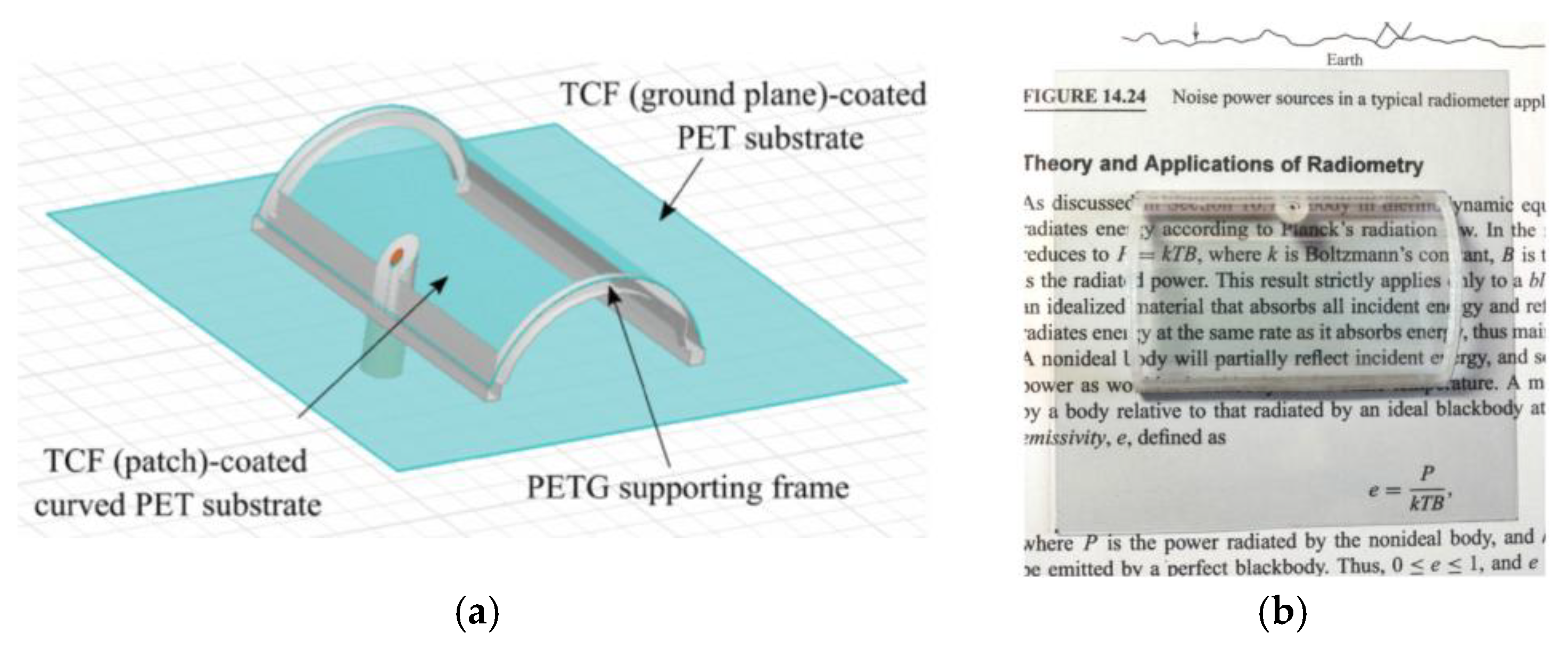
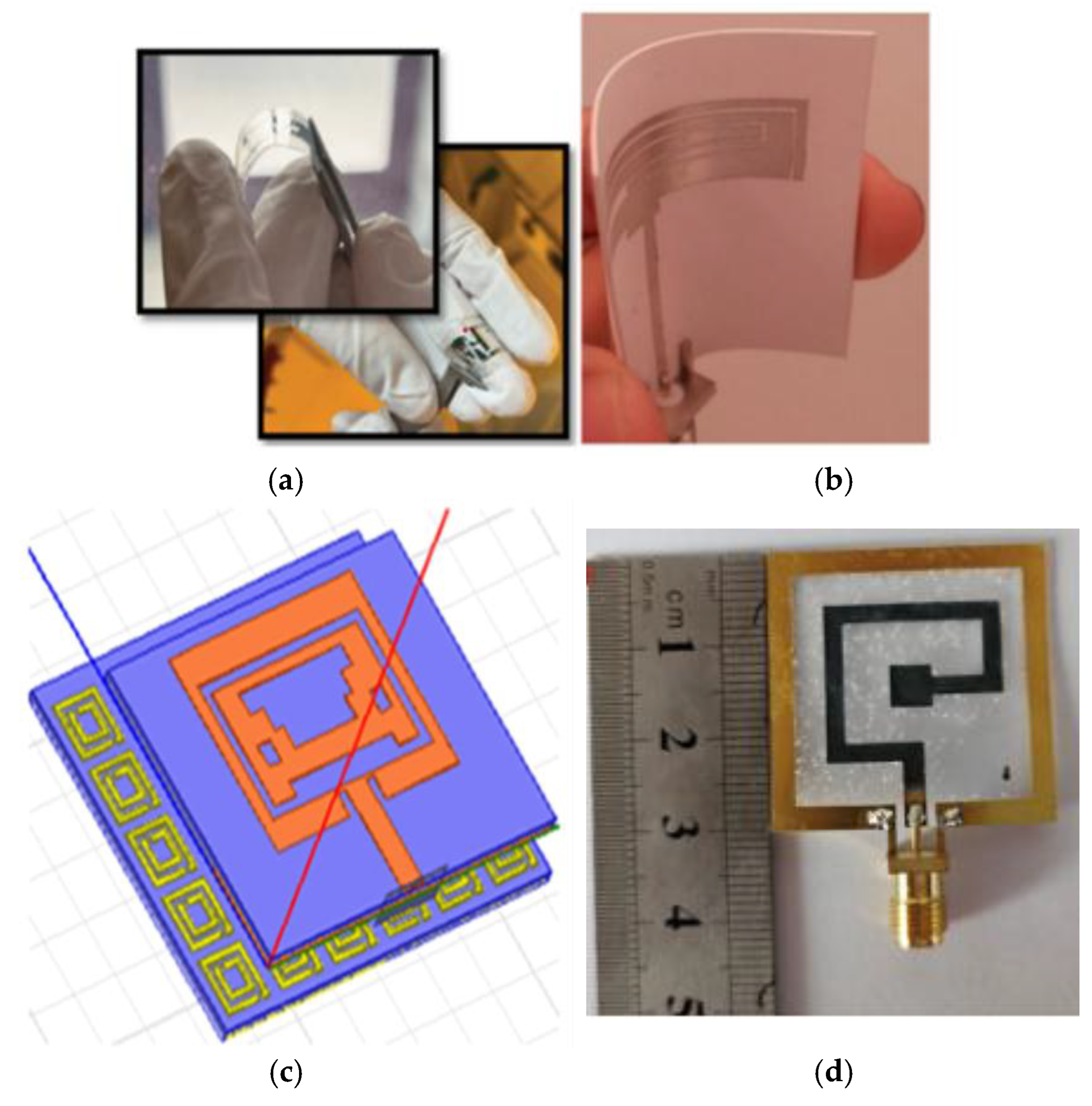
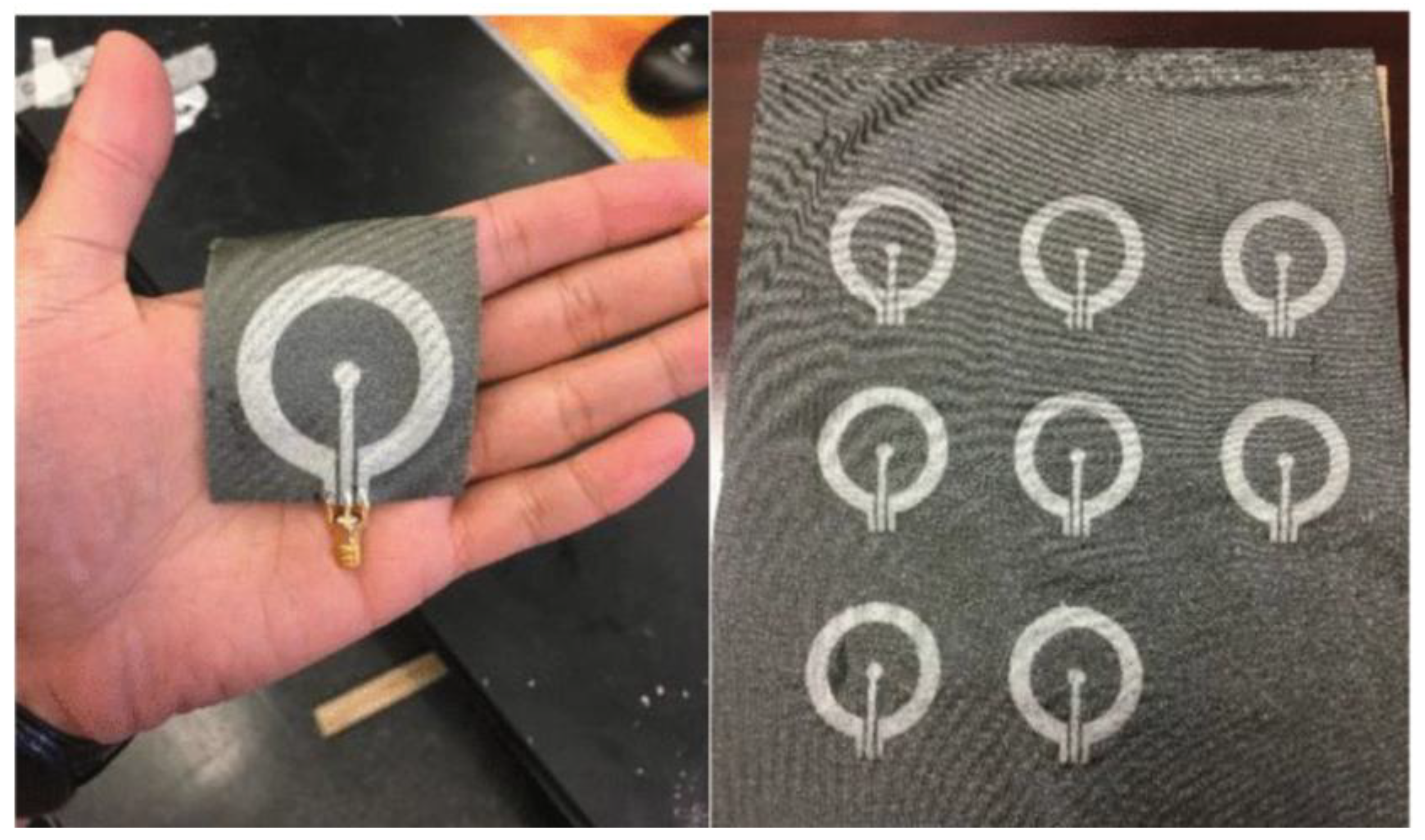
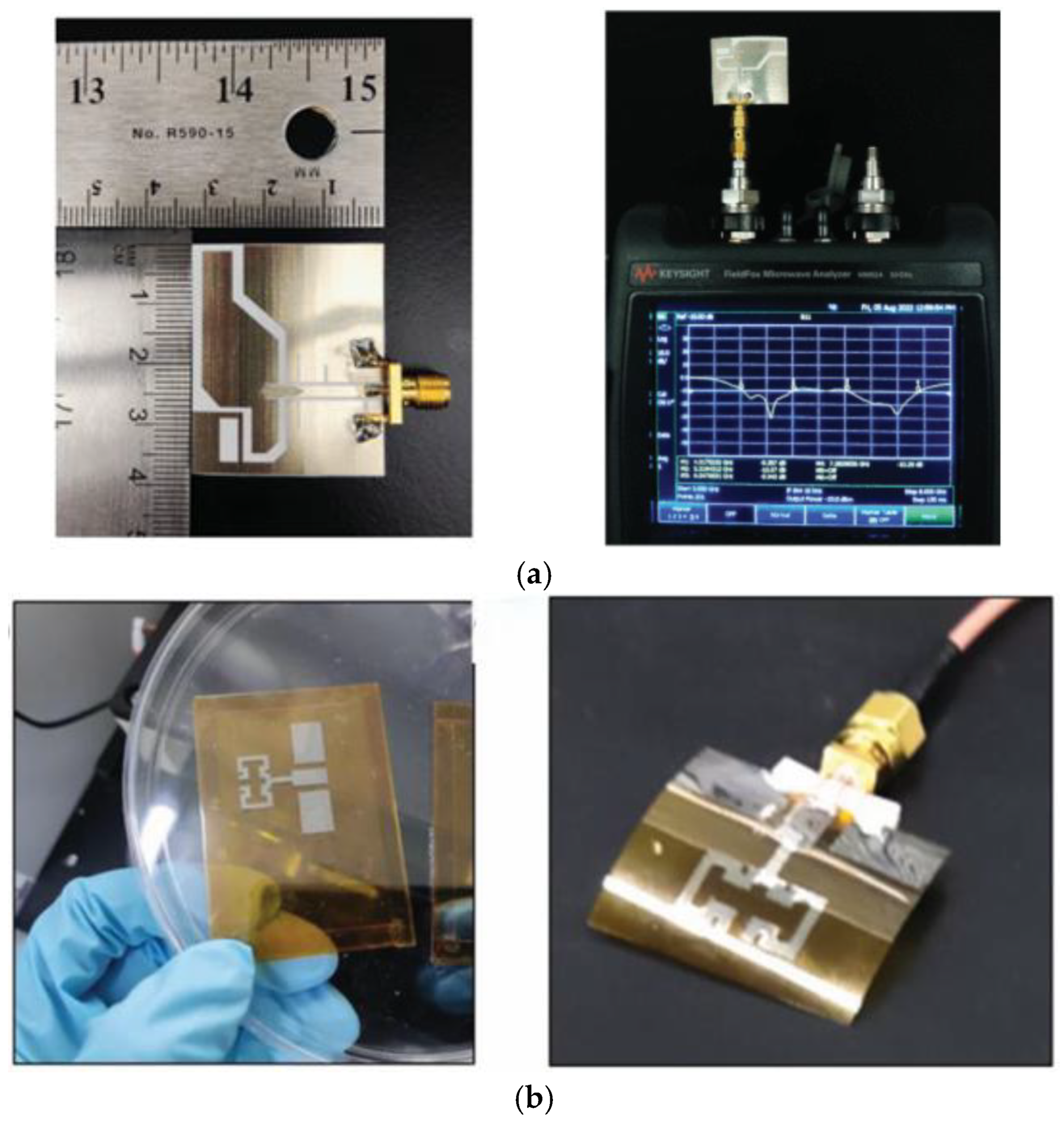
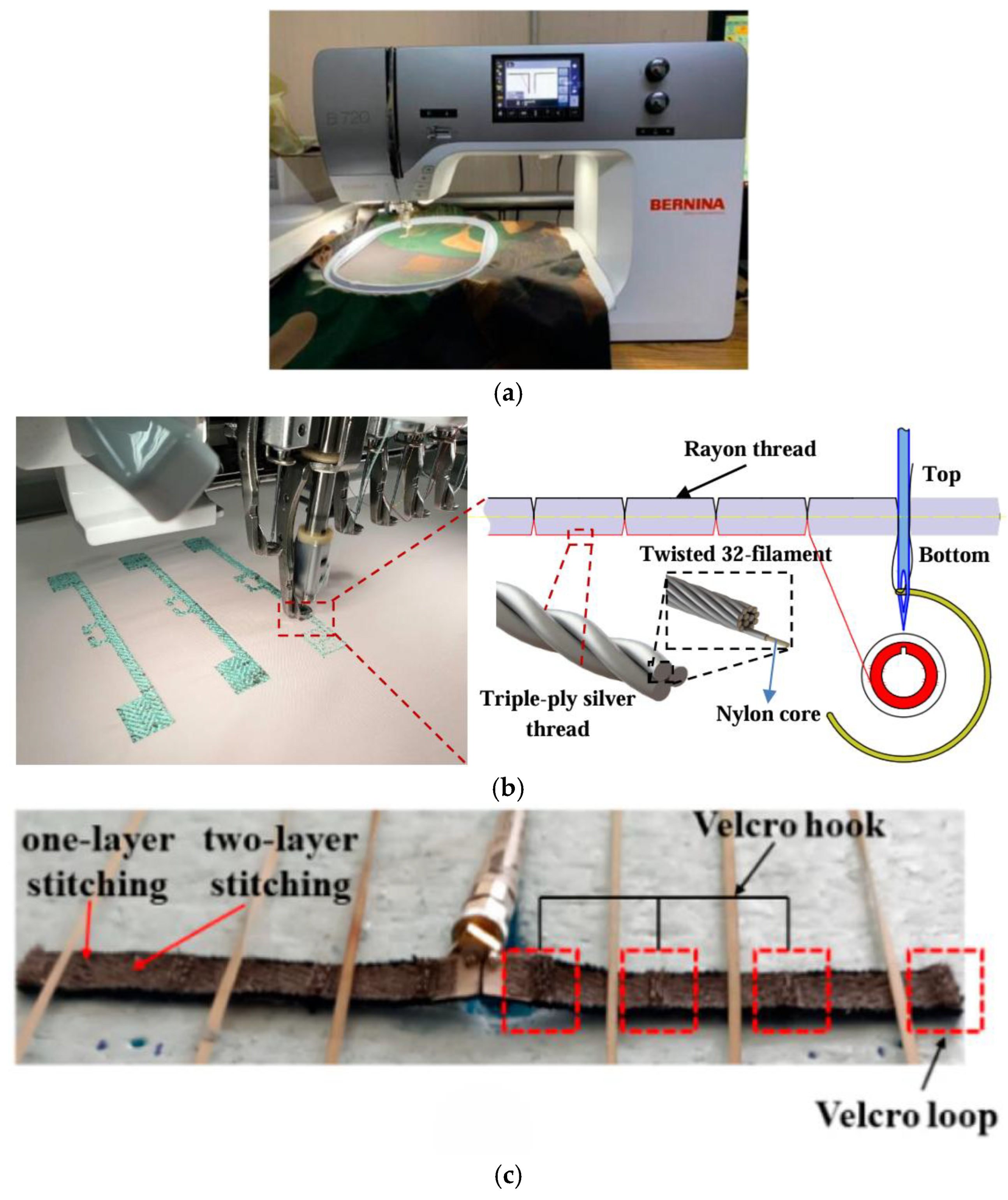

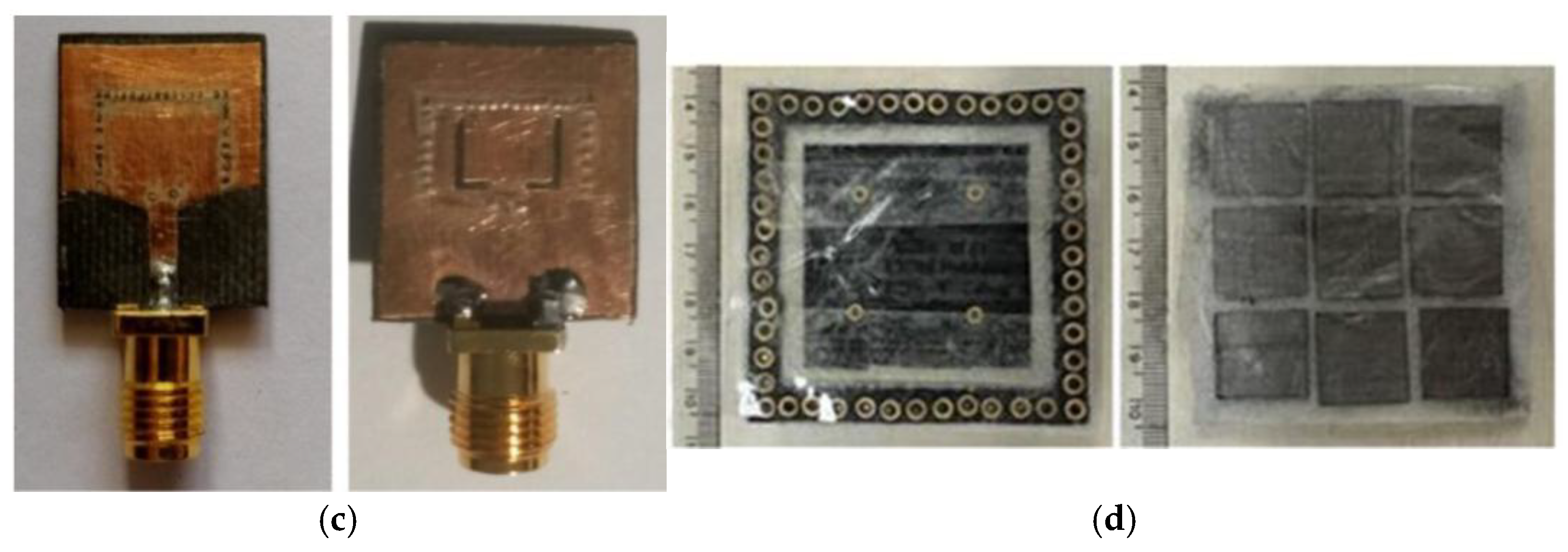

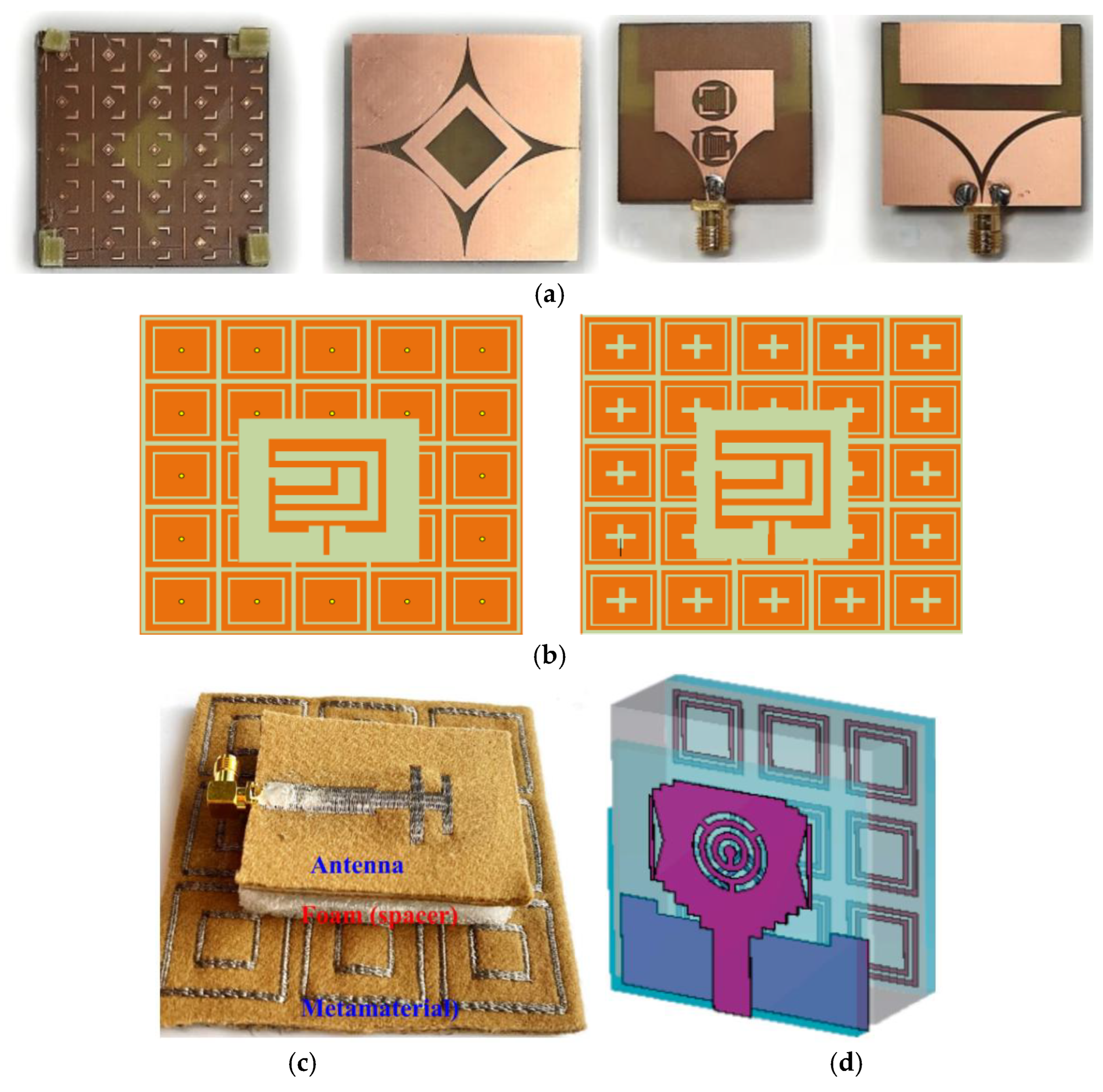



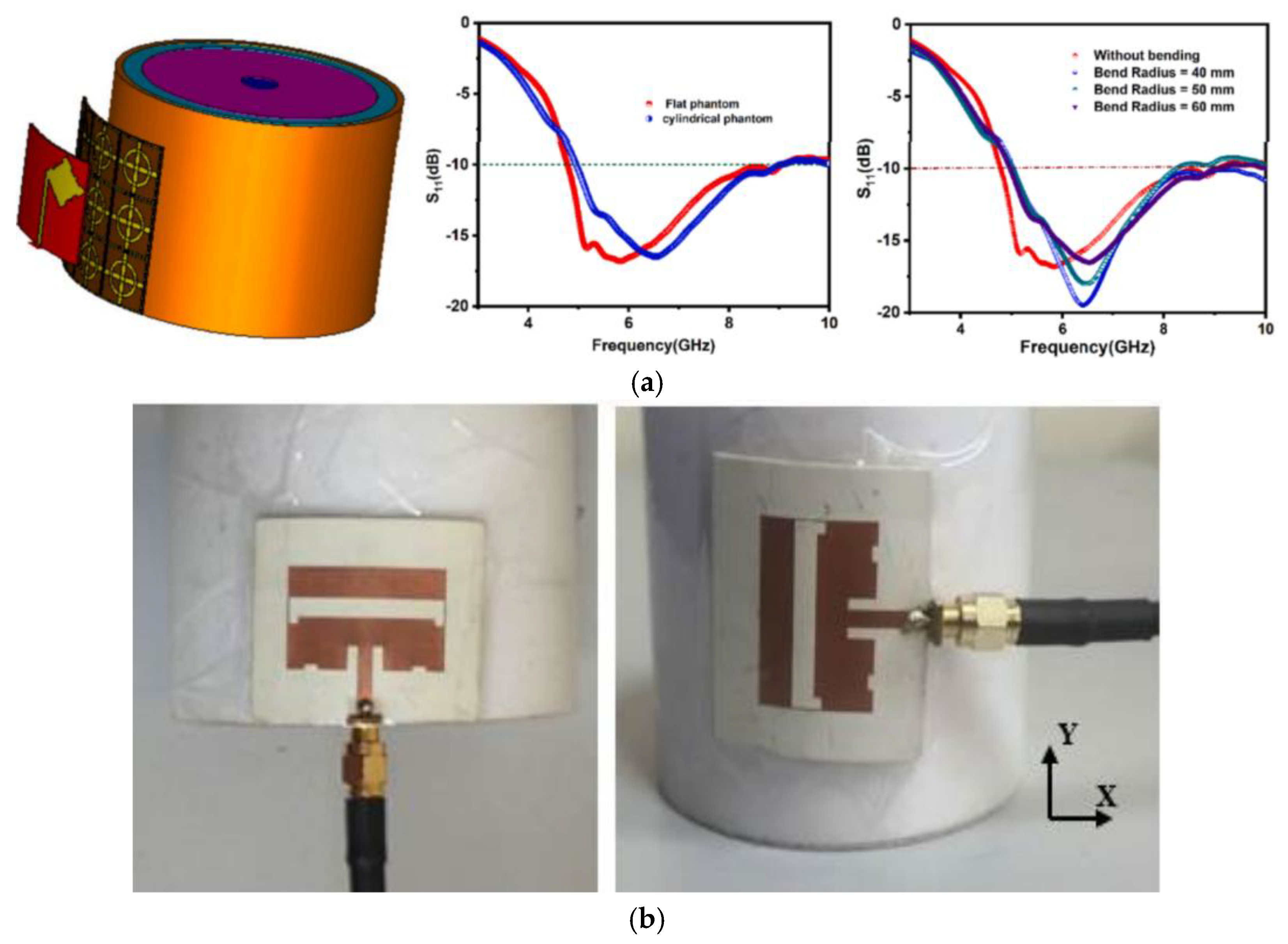

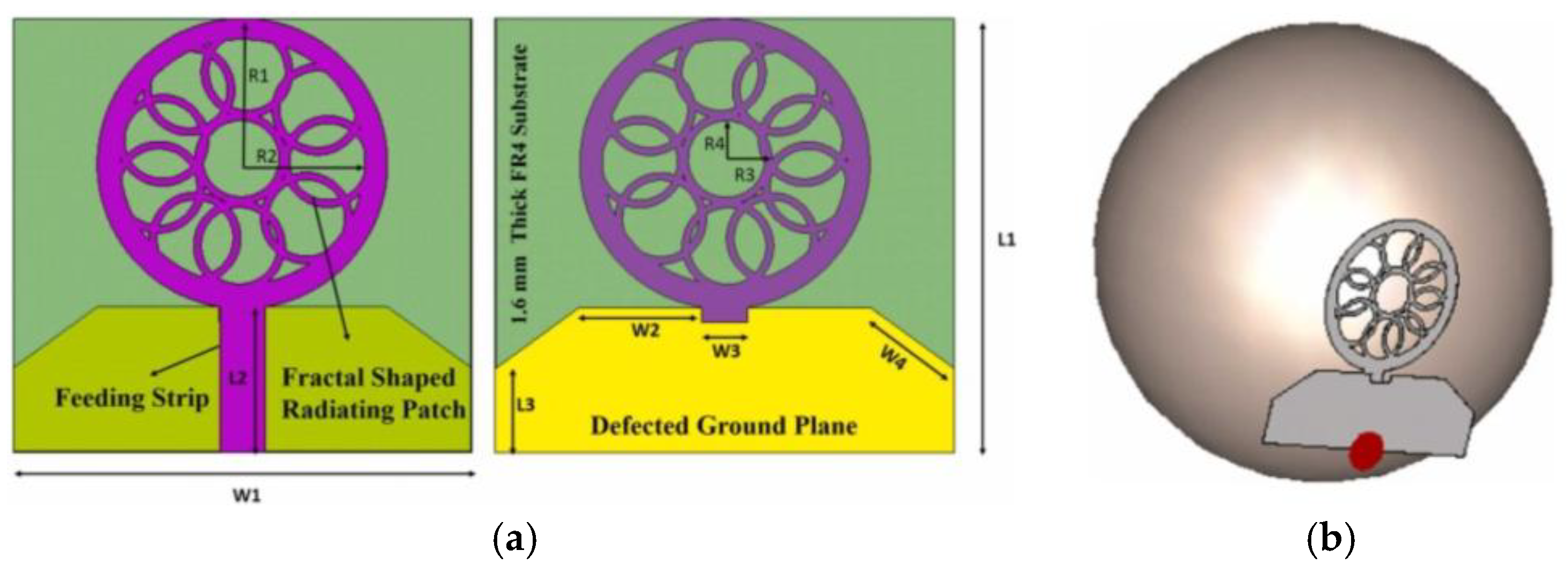


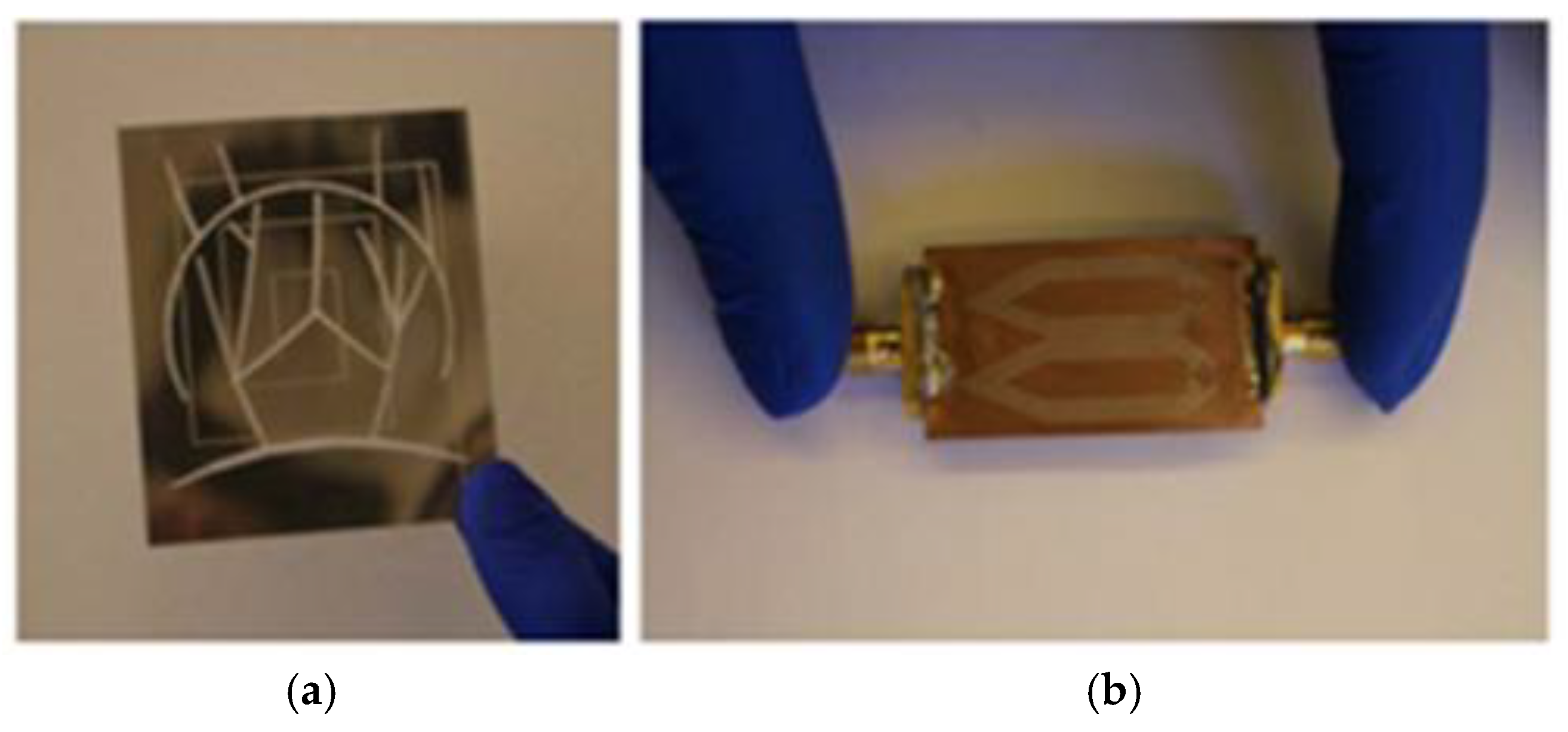
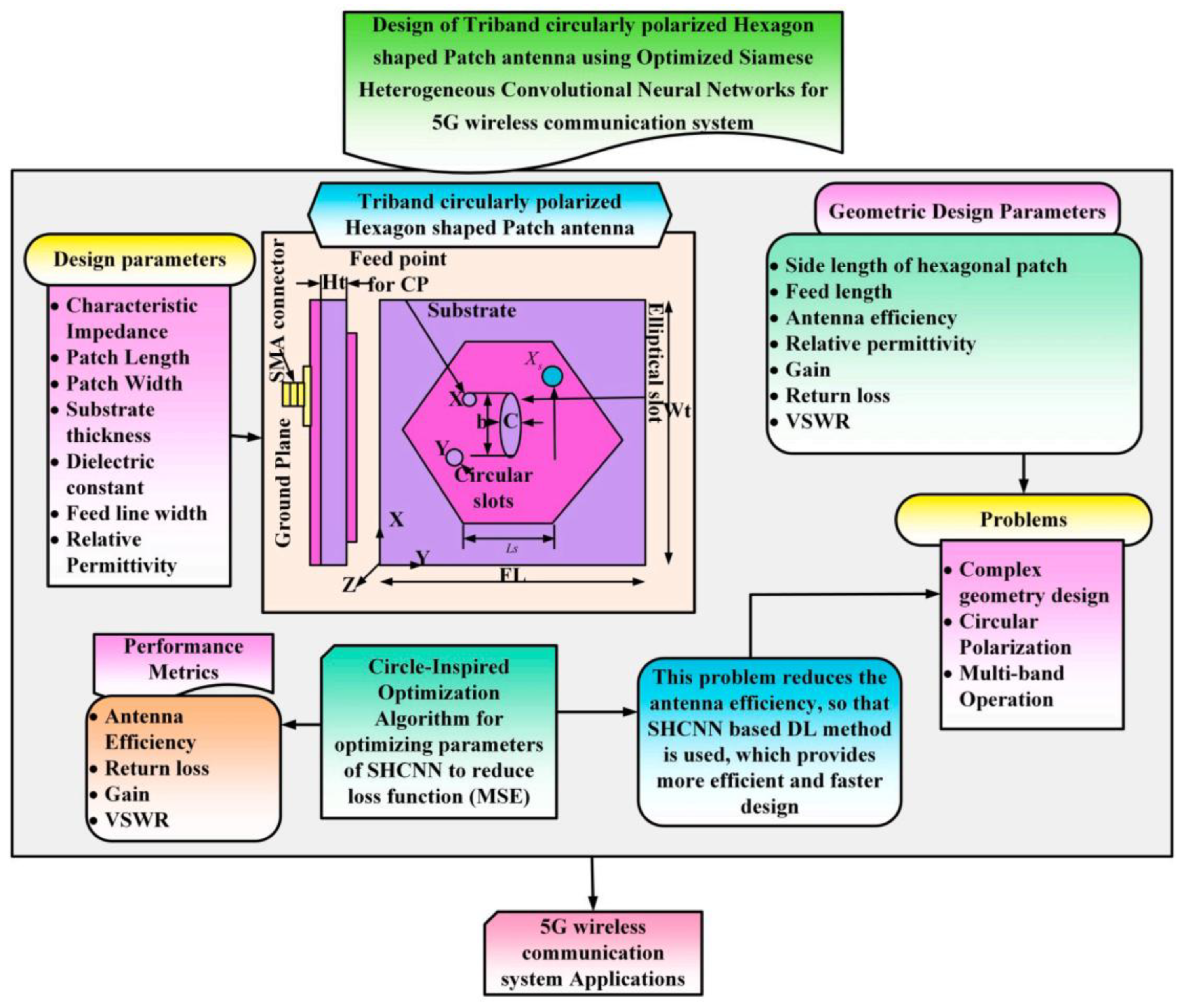
| Conductive Material | Conductivity σ (S/m) | Thickness t (mm) |
|---|---|---|
| Copper [17] | 5.9 × 107 | 0.035 |
| Aluminum [18] | 3.8 × 107 | 0.01 |
| Stainless steel [19] | 1.0 × 106 | 0.45 |
| Silver ink [24] | 1.97 × 106 | 0.12 |
| Graphene [26] | 1.1 × 106 | 0.028 |
| Copper–polyester taffeta [27] | 0.4 × 105 | 0.08 |
| Dielectric Material | Dielectric Constant (ε) | Dielectric Loss (tanδ) | Frequency Range |
|---|---|---|---|
| PET [28] | 2.5 | 0.01 | 2.025–2.29 (GHz) |
| FR4 [29] | 4.4 | 0.025 | 10.14–10.94 (GHz) |
| Denim [34] | 1.7 | 0.024 | 2.4–14.88 (GHz) |
| Felt [35] | 1.3 | 0.044 | 2.4–2.5 (GHz) |
| Rubber [37] | 3.1 | 0.02 | 2.4–2.5 (GHz) |
| PTFE [44] | 2.2 | 0.002 | 2.4 (GHz) |
| Synthetic paper [48] | 2 | 0.0022 | 1.83–2.9 (GHz), 3.4–3.6 (GHz), 4.6–5.86 (GHz) |
| PI [49] | 3.5 | 0.008 | 3.62 (THz) |
| PET paper [51] | 3.2 | 0.022 | 4.01–5.05 (GHz), 6.23–7.58 (GHz) |
| Ref. | Substrate | Radius (mm) | Dimensions | Application |
|---|---|---|---|---|
| [90] | Polyethylene foam | (40, 60, 70) | 68 × 73 × 3 (mm3) | WLAN |
| [91] | Felt | Rx (15, 30, 45) Ry (15, 30, 45) | 0.41λ0 × 0.45λ0 × 0.016λ0 | ISM |
| [94] | Jeans | Rx (70, 80, 100) Ry (70, 80, 100) | 60 × 60 × 2.4 (mm3) | MBAN |
| [109] | Jeans | (40, 50, 60) | 27 × 27.5 × 1 (mm3) | WBAN |
| [110] | Rogers 3003 | Rx (50, 80, 100) Ry (50, 80, 100) | 41 × 44 × 1.52 (mm3) | WBAN |
| [111] | Denim | (25, 35, 45) | 60 × 60 × 1 (mm3) | ISM |
| [112] | Rogers 3003 | Rx (40, 60, 80) Ry (25, 50, 75) | 11 × 11 × 0.25 (mm3) | MM-WAVE |
| Ref. | Antenna Type | Frequency | Dimensions | Dielectric Materials | Peak of Gain | Bandwidth | Application |
|---|---|---|---|---|---|---|---|
| [114] | UWB antenna | 3.1–10.6 (GHz) | 60 × 60 (mm) | Felt | 4.5 (dBi) | 8.5 GHz | Breast cancer detection |
| [115] | UWB antenna | 8.2–13 (GHz) | 36 × 48 (mm) | Felt | 7.04 (dB) | 4.8 (GHz) | Skin cancer detection |
| [116] | Antenna array | 2.4 (GHz) | 200 × 78 (mm) | FR4 | 6.6 (dBi) | 1 (GHz) | Kidney cancer detection |
| [117] | H-type patch antenna | 5.4 (GHz) | 50 × 50 (mm) | RT/duroid® 5880 | 5.25 (dB) | - | Thyroid cancer detection |
| [118] | U-shaped textile antenna | 5.4 (GHz) | 0.41λ0 × 0.54λ0 | Non-woven polyester fabric | 9.17 (dB) | 952 (MHz) | Thyroid cancer detection |
| [119] | UWB stacked micro-strip antenna | 6.1–12.3 (GHz) | 36 × 30 (mm) | FR4 | 6.3 (dB) | 6.2 (GHz) | Skin cancer detection |
| [121] | Reconfigurable antenna array | 2.4 (GHz) | 200 × 78 (mm) | FR4 | 3.1 (dB) | 90.9 (MHz) | Brain cancer detection |
| [123] | Flexible antenna sensor | 4.1 (GHz) | 12 × 20 (mm) | PI | 1.72 (dBi) | - | Blood glucose detection |
| [125] | UWB fractal antenna | 3–10.2 (GHz) | 28.5 × 20 (mm) | FR4 | 3.2 (dBi) | 6.8 (GHz) | Breast cancer detection |
| [127] | Dipole antenna | 2.4 (GHz) | 45 × 4.8 (mm) | Cotton | 1.86 (dB) | - | Breath detection |
| [133] | UBW antenna | 3.15–10.55 (GHz) | 16 × 10 (mm) | Polyimide | 4.2 (dBi) | 7.4 (GHz) | Health monitoring |
| [134] | AMC antenna | 2.37–3.12 (GHz) | 81 × 81 (mm) | FR4 | 6.2 (dBi) | 750 (MHz) | Pulmonary edema monitoring |
| [135] | Textile antenna senor | 2.4 (GHz) | 40 × 50 (mm) | Thermoplastic polyurethane | - | - | Breathing monitoring |
| [138] | AMC antenna | 23–27 (GHz) | 9.6 × 14.1 (mm) | RO3003 | 6.73 (dBi) | 4 (GHz) | Electronic travel aid |
| Ref. | Method | Advantages | Conclusion | Application |
|---|---|---|---|---|
| [146] | 5-layer DNN model + Mixed Gravitational Search-Particle Swarm Algorithm | MGSA-PSO optimizes feeding phases | Combination of DNN and hybrid algorithms enables efficient beamforming | 5G mm-Wave communication systems |
| [147] | Siamese Heterogeneous Convolutional Network + Circle-Inspired Optimization Algorithm | Shorten the design time | Algorithm combined with heterogeneous network for efficient multi-band circular polarization design | Multi-band communication for 5G base stations/UE devices |
| [148] | Ensemble Boosted Tree + Trilayered Neural Network + Fine Tree | Simultaneously optimize AR and S11 using machine learning methods. | Machine learning predictions align with simulation and actual measurement data. | Satellite and radar applications |
| [149] | GST-HBA algorithm: Tent chaos initialization + Golden Sine mechanism | Multi-function validation for optimization accuracy | Algorithm improvement significantly boosts optimization efficiency for complex electromagnetic problems | Antenna design parameter optimization |
| [150] | Adaptive NSGA-III multi-objective optimization algorithm | Pseudo-weight NSGA-III enhances Pareto front diversity | Data-driven modeling combined with optimization shortens design cycles, suitable for rapid iteration of complex parameters in high-frequency bands | Fast multi-objective optimization for 5G/6G mm-Wave antennas |
Disclaimer/Publisher’s Note: The statements, opinions and data contained in all publications are solely those of the individual author(s) and contributor(s) and not of MDPI and/or the editor(s). MDPI and/or the editor(s) disclaim responsibility for any injury to people or property resulting from any ideas, methods, instructions or products referred to in the content. |
© 2025 by the authors. Licensee MDPI, Basel, Switzerland. This article is an open access article distributed under the terms and conditions of the Creative Commons Attribution (CC BY) license (https://creativecommons.org/licenses/by/4.0/).
Share and Cite
Cao, Z.; Lu, M. Advancements in Wearable Antenna Design: A Comprehensive Review of Materials, Fabrication Techniques, and Future Trends in Wireless Communication. Micromachines 2025, 16, 1028. https://doi.org/10.3390/mi16091028
Cao Z, Lu M. Advancements in Wearable Antenna Design: A Comprehensive Review of Materials, Fabrication Techniques, and Future Trends in Wireless Communication. Micromachines. 2025; 16(9):1028. https://doi.org/10.3390/mi16091028
Chicago/Turabian StyleCao, Zhikai, and Mai Lu. 2025. "Advancements in Wearable Antenna Design: A Comprehensive Review of Materials, Fabrication Techniques, and Future Trends in Wireless Communication" Micromachines 16, no. 9: 1028. https://doi.org/10.3390/mi16091028
APA StyleCao, Z., & Lu, M. (2025). Advancements in Wearable Antenna Design: A Comprehensive Review of Materials, Fabrication Techniques, and Future Trends in Wireless Communication. Micromachines, 16(9), 1028. https://doi.org/10.3390/mi16091028




